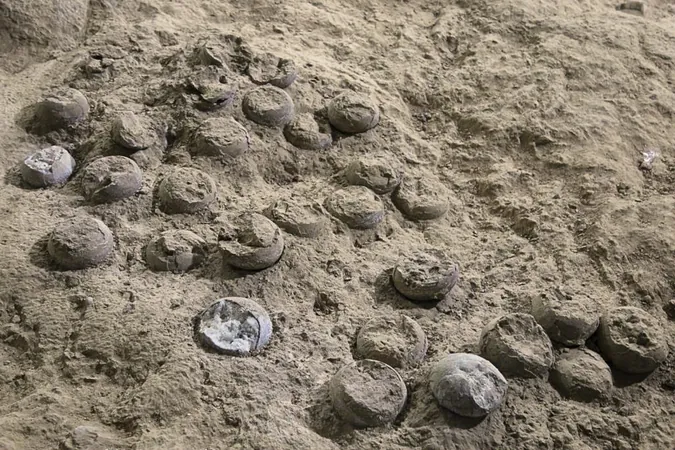
28 Dinosaur Eggs Unearthed in China: Why Scientists Fired a Laser at Them
2025-09-11
Author: Arjun
A Groundbreaking Discovery in Dinosaur Research
In an astonishing revelation, a team of scientists has unearthed a cluster of dinosaur eggs in Central China and utilized a cutting-edge method called in-situ carbonate uranium-lead (U-Pb) dating to uncover their origins.
Traditionally, dating dinosaur eggs and bones relied on indirect techniques that involved analyzing nearby volcanic rocks or ash. However, U-Pb dating allows researchers to pinpoint the exact age of the eggs for the first time, revealing they were laid approximately 85.91 million years ago during the Late Cretaceous period.
Unraveling the Mystery
Bi Zhao, a researcher at the Hubei Institute of Geosciences, expressed enthusiasm about this breakthrough: "We provide the first robust chronological constraints for these fossils, resolving long-standing uncertainties about their age." This significant age determination not only sheds light on the timing of these eggs but also offers insights into the conditions of the planet at that time.
A Site Rich in Fossils
The eggs, discovered at the Qinglongshan site in Shiyan’s Yunyang District, belong to a single species named Placoolithus tumiaolingensis. Researchers have unearthed over 3,000 fossilized eggs here, which are remarkably well-preserved and largely intact, hinting at their ancient lineage.
Interestingly, these eggs, characterized by their porous shells, were likely laid by two-legged theropod dinosaurs, a group that includes some of the fiercest creatures of their time.
High-Tech Age Determination
To date the 28 eggs that were the focus of this study, Zhao and his team harnessed the innovative U-Pb dating method. This involved firing a micro-laser at the eggshells, vaporizing carbonate minerals to analyze their uranium and lead content. This process acts like an atomic clock, allowing for precise age calculation based on uranium decay.
Insights into Earth's Climate History
The timing of these eggs' deposition aligns with a period of significant global climate change. During the Turonian Epoch, just before these eggs were laid, global temperatures drastically decreased, a transition that likely influenced the decline of dinosaur diversity toward the Cretaceous's end. Zhao emphasized, "Our achievement holds significant implications for research on dinosaur evolution and extinction, as well as environmental changes on Earth during the Late Cretaceous."
A New Chapter in Paleontology
These findings do not just illuminate the past; they revolutionize our understanding of how dinosaurs adapted to dramatic changes in their environment. As researchers continue to study these ancient eggs, they hope to weave compelling narratives about Earth's history and the incredible creatures that once roamed its surface.
For more in-depth insights, refer to the study published in the journal 'Frontiers in Earth Science', detailing the geological age of the Yunyang dinosaur eggs and its scientific implications.



 Brasil (PT)
Brasil (PT)
 Canada (EN)
Canada (EN)
 Chile (ES)
Chile (ES)
 Česko (CS)
Česko (CS)
 대한민국 (KO)
대한민국 (KO)
 España (ES)
España (ES)
 France (FR)
France (FR)
 Hong Kong (EN)
Hong Kong (EN)
 Italia (IT)
Italia (IT)
 日本 (JA)
日本 (JA)
 Magyarország (HU)
Magyarország (HU)
 Norge (NO)
Norge (NO)
 Polska (PL)
Polska (PL)
 Schweiz (DE)
Schweiz (DE)
 Singapore (EN)
Singapore (EN)
 Sverige (SV)
Sverige (SV)
 Suomi (FI)
Suomi (FI)
 Türkiye (TR)
Türkiye (TR)
 الإمارات العربية المتحدة (AR)
الإمارات العربية المتحدة (AR)